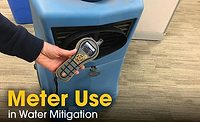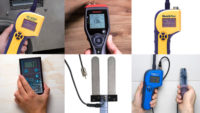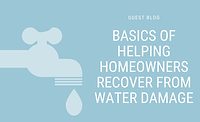5 Tips for Basic Moisture Meter Use

One of the most important tools in a restoration contractor's tool belt is a good quality moisture meter. Even when the origin of water damage is out of sight at a customer's property, a moisture meter can be used to determine the extent of the damage, how far the moisture has traveled, and potentially pinpoint the source. All these reasons, and more, make moisture meters an indispensable tool for water damage restoration professionals.
Of course a moisture meter has to be accurate to provide you with the best results. If you have a moisture meter, then you will find these five tips to ensure moisture meter accuracy useful.
1. Calibrate Your Moisture Meter Properly
It is important to recalibrate your moisture meter properly every single time you use it. That way, you can be sure that your device makes the right assessment of the composition of the material you’re using it on and reach a reading that is as accurate as possible.
2. Use The Right Moisture Meter
There are different types of moisture meters: pin and pinless. Depending on the type of material you are trying to test, one may be more useful than the other. For example, a pin moisture meter can be inserted into a hardwood floor to determine the depth of the moisture damage. Similarly, a pinless meter has the ability to detect the breadth of the damage across the service, but not able to detect moisture as far into the surface as a pin. There are certainly pros and cons to both options. There is one designed to test the moisture content of wood. Another type is meant to measure the moisture content of concrete.
3. Do Multiple Readings
One way of making sure you’re getting a precise moisture reading is by doing it more than once. An accurate moisture meter should be giving you a similar, even identical, reading of the moisture level in the same area no matter how many times you do it. If the readings aren’t consistent, then there might be something wrong with your tool.
4. Consider Temperature and Material
You should always take the temperature as well as the materials you’re testing into consideration to ensure you’re getting an accurate reading. Temperature, after all, does affect relative moisture levels in the air, although in most cases, the changes won’t probably be too significant. What would affect the accuracy of a reading are extreme changes in temperature.
Wood, concrete, and other materials also absorb varying levels of moisture, so you would do well to consider the material, too, to get an accurate reading.
5. Moisture Meter Maintenance
A moisture meter is a tool, and like all tools, it needs to be cleaned and stored properly.
With their constant exposure to water content when in use, moisture meters need to be wiped down regularly, particularly its pins. Once you’re done wiping it, put it back in its case and store it somewhere safe for optimum protection.
By performing the most basic of cleaning and maintenance work on your moisture meter, you should be able to get it working like new every single time, and for longer. Regular wipe-downs will help your instrument avoid rusty or broken pins, and storing it properly will help prevent any structural issues that may lead to inaccurate readings in the future.
Looking for a reprint of this article?
From high-res PDFs to custom plaques, order your copy today!







